TOYOTA PRIUS PRIME 2023 Owners Manual
Manufacturer: TOYOTA, Model Year: 2023, Model line: PRIUS PRIME, Model: TOYOTA PRIUS PRIME 2023Pages: 680, PDF Size: 14.97 MB
Page 301 of 680
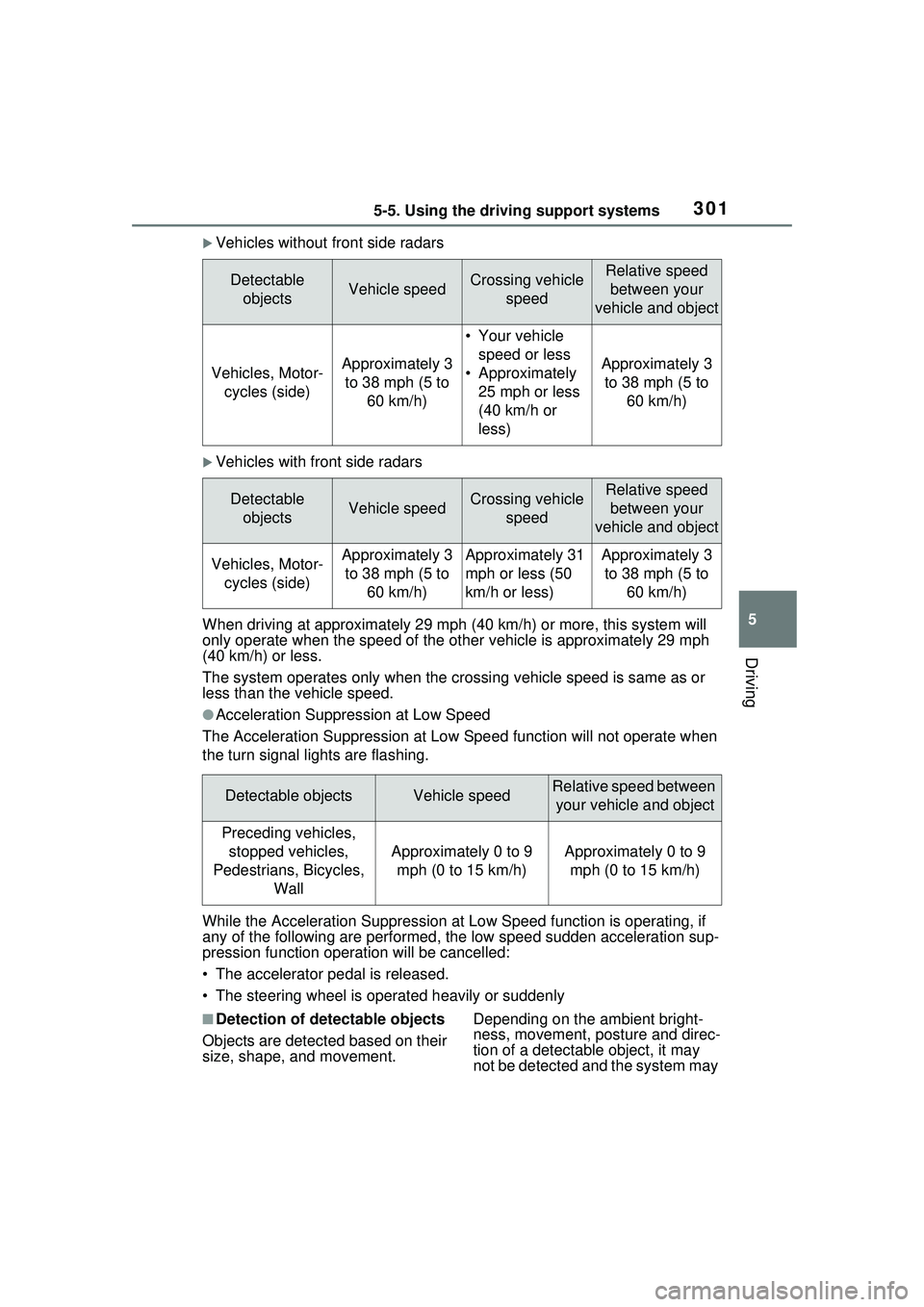
3015-5. Using the driving support systems
5
Driving
Vehicles without front side radars
Vehicles with front side radars
When driving at approximately 29 m ph (40 km/h) or more, this system will
only operate when the speed of the ot her vehicle is approximately 29 mph
(40 km/h) or less.
The system operates only when the crossing vehicle speed is same as or
less than the vehicle speed.
●Acceleration Suppression at Low Speed
The Acceleration Suppression at Low Speed function will not operate when
the turn signal lights are flashing.
While the Acceleration Suppression at Low Speed function is operating, if
any of the following are performed, the low speed sudden acceleration sup-
pression function operation will be cancelled:
• The accelerator pedal is released.
• The steering wheel is operated heavily or suddenly
■Detection of detectable objects
Objects are detected based on their
size, shape, and movement. Depending on the ambient bright-
ness, movement, posture and direc-
tion of a detectable object, it may
not be detected and the system may
Detectable
objectsVehicle speedCrossing vehicle speedRelative speed between your
vehicle and object
Vehicles, Motor- cycles (side)Approximately 3 to 38 mph (5 to 60 km/h)
• Your vehicle speed or less
• Approximately 25 mph or less
(40 km/h or
less)
Approximately 3 to 38 mph (5 to 60 km/h)
Detectable objectsVehicle speedCrossing vehicle speedRelative speed between your
vehicle and object
Vehicles, Motor- cycles (side)Approximately 3 to 38 mph (5 to 60 km/h)Approximately 31
mph or less (50
km/h or less)Approximately 3 to 38 mph (5 to 60 km/h)
Detectable objectsVehicle speedRelative speed between your vehicle and object
Preceding vehicles, stopped vehicles,
Pedestrians, Bicycles, Wall
Approximately 0 to 9 mph (0 to 15 km/h)Approximately 0 to 9 mph (0 to 15 km/h)
Page 302 of 680
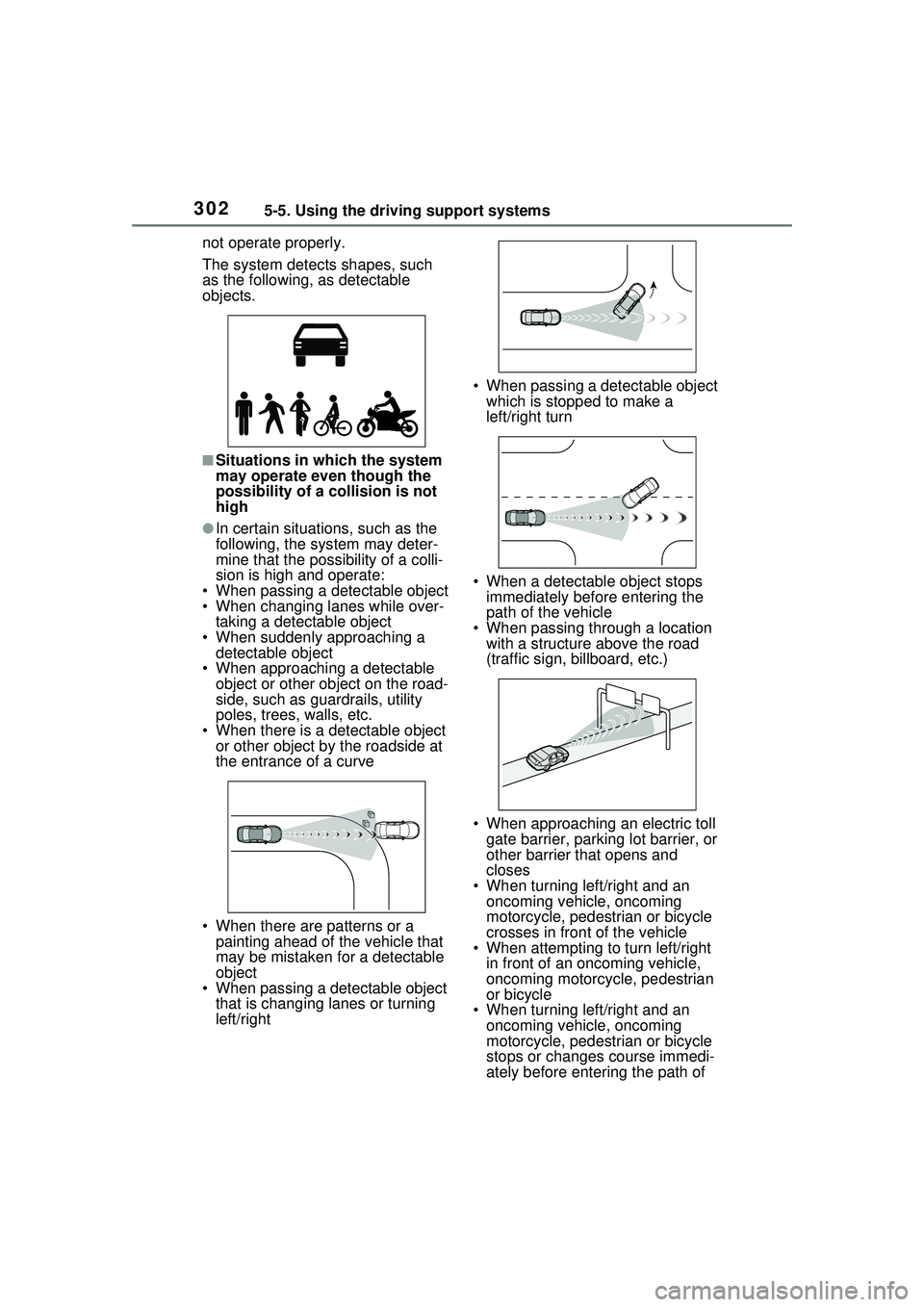
3025-5. Using the driving support systems
not operate properly.
The system detects shapes, such
as the following, as detectable
objects.
■Situations in which the system
may operate even though the
possibility of a collision is not
high
●In certain situations, such as the
following, the system may deter-
mine that the possibility of a colli-
sion is high and operate:
• When passing a detectable object
• When changing lanes while over- taking a detectable object
• When suddenly approaching a detectable object
• When approaching a detectable
object or other object on the road-
side, such as guardrails, utility
poles, trees, walls, etc.
• When there is a detectable object or other object by the roadside at
the entrance of a curve
• When there are patterns or a painting ahead of the vehicle that
may be mistaken for a detectable
object
• When passing a detectable object
that is changing lanes or turning
left/right • When passing a detectable object
which is stopped to make a
left/right turn
• When a detectable object stops immediately before entering the
path of the vehicle
• When passing through a location with a structure above the road
(traffic sign, billboard, etc.)
• When approaching an electric toll gate barrier, parking lot barrier, or
other barrier that opens and
closes
• When turning left/right and an oncoming vehicle, oncoming
motorcycle, pedestrian or bicycle
crosses in front of the vehicle
• When attempting to turn left/right in front of an oncoming vehicle,
oncoming motorcycle, pedestrian
or bicycle
• When turning left/right and an
oncoming vehicle, oncoming
motorcycle, pedestrian or bicycle
stops or changes course immedi-
ately before entering the path of
Page 303 of 680
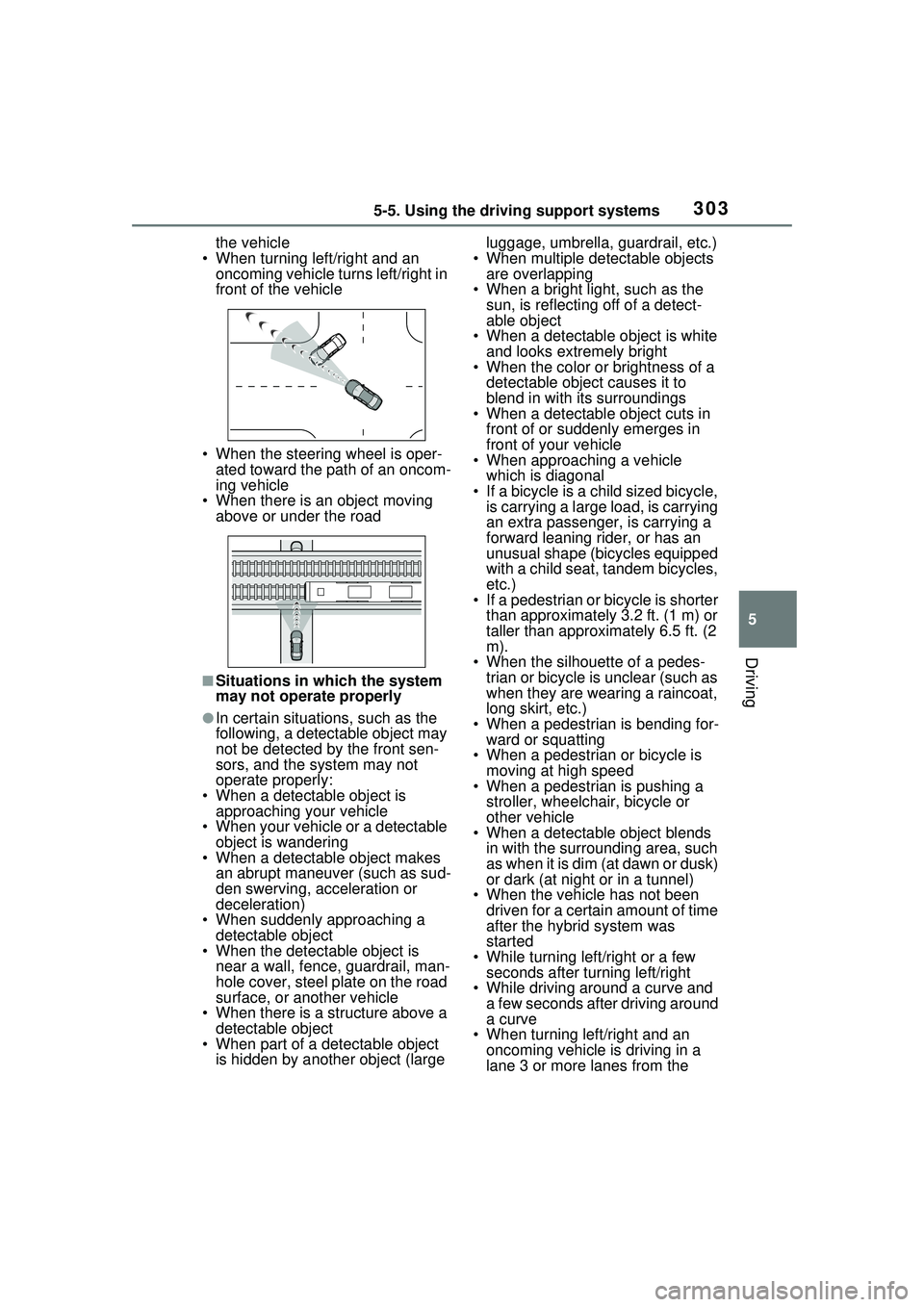
3035-5. Using the driving support systems
5
Driving
the vehicle
• When turning left/right and an oncoming vehicle turns left/right in
front of the vehicle
• When the steering wheel is oper- ated toward the path of an oncom-
ing vehicle
• When there is an object moving
above or under the road
■Situations in which the system
may not operate properly
●In certain situations, such as the
following, a detectable object may
not be detected by the front sen-
sors, and the system may not
operate properly:
• When a detectable object is approaching your vehicle
• When your vehicle or a detectable object is wandering
• When a detectable object makes
an abrupt maneuver (such as sud-
den swerving, acceleration or
deceleration)
• When suddenly approaching a detectable object
• When the detectable object is
near a wall, fence, guardrail, man-
hole cover, steel plate on the road
surface, or another vehicle
• When there is a structure above a
detectable object
• When part of a detectable object is hidden by another object (large luggage, umbrella, guardrail, etc.)
• When multiple detectable objects are overlapping
• When a bright light, such as the sun, is reflecting off of a detect-
able object
• When a detectable object is white and looks extremely bright
• When the color or brightness of a
detectable object causes it to
blend in with its surroundings
• When a detectable object cuts in
front of or suddenly emerges in
front of your vehicle
• When approaching a vehicle
which is diagonal
• If a bicycle is a child sized bicycle, is carrying a large load, is carrying
an extra passenger, is carrying a
forward leaning rider, or has an
unusual shape (bicycles equipped
with a child seat, tandem bicycles,
etc.)
• If a pedestrian or bicycle is shorter
than approximately 3.2 ft. (1 m) or
taller than approximately 6.5 ft. (2
m).
• When the silhouette of a pedes- trian or bicycle is unclear (such as
when they are wearing a raincoat,
long skirt, etc.)
• When a pedestrian is bending for- ward or squatting
• When a pedestrian or bicycle is moving at high speed
• When a pedestrian is pushing a
stroller, wheelchair, bicycle or
other vehicle
• When a detectable object blends
in with the surrounding area, such
as when it is dim (at dawn or dusk)
or dark (at night or in a tunnel)
• When the vehicle has not been driven for a certain amount of time
after the hybrid system was
started
• While turning left/right or a few seconds after turning left/right
• While driving around a curve and
a few seconds after driving around
a curve
• When turning left/right and an
oncoming vehicle is driving in a
lane 3 or more lanes from the
Page 304 of 680
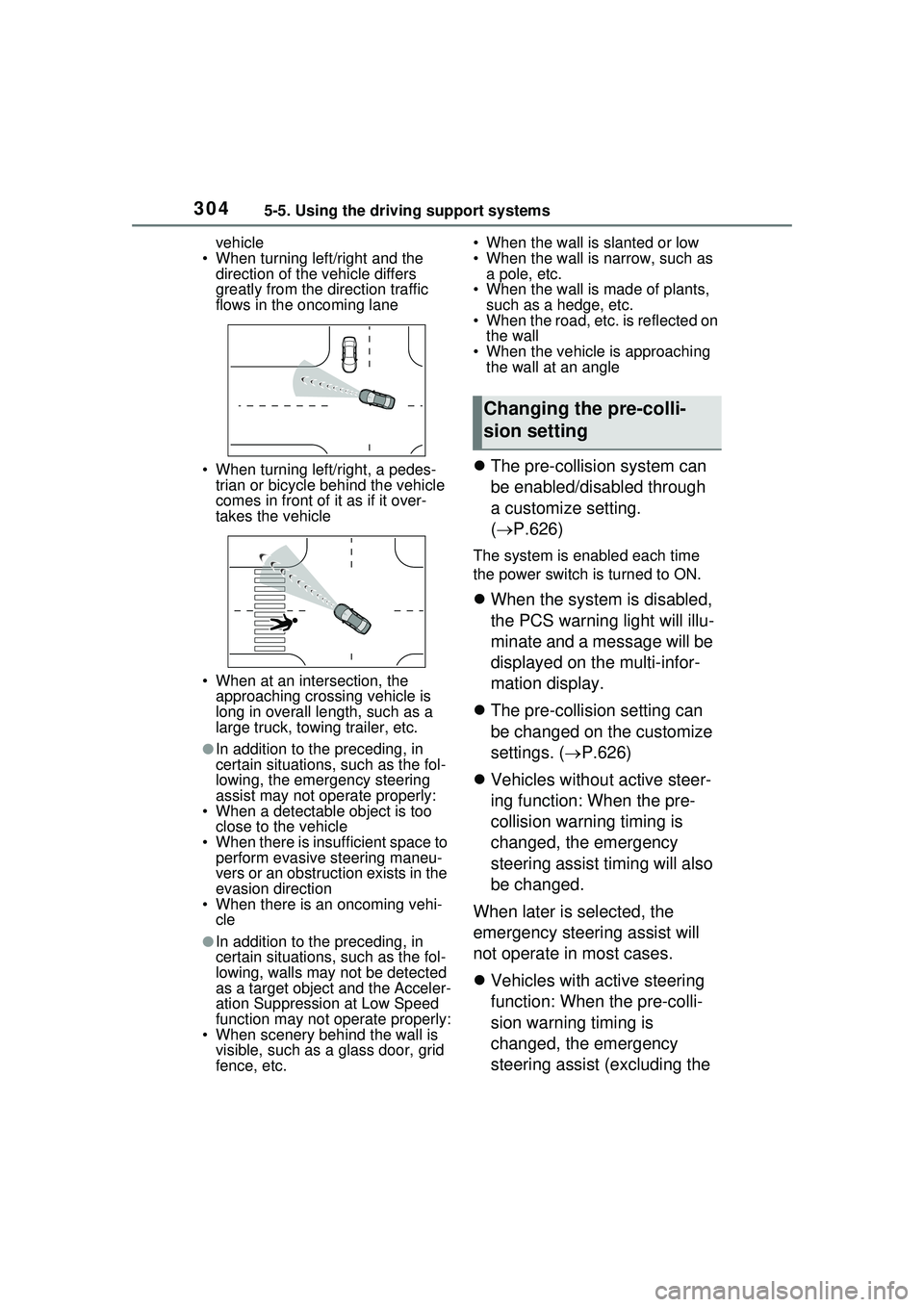
3045-5. Using the driving support systems
vehicle
• When turning left/right and the direction of the vehicle differs
greatly from the direction traffic
flows in the oncoming lane
• When turning left/right, a pedes- trian or bicycle behind the vehicle
comes in front of it as if it over-
takes the vehicle
• When at an intersection, the approaching crossing vehicle is
long in overall le ngth, such as a
large truck, towing trailer, etc.
●In addition to the preceding, in
certain situations, such as the fol-
lowing, the emergency steering
assist may not operate properly:
• When a detectable object is too
close to the vehicle
• When there is insufficient space to perform evasive steering maneu-
vers or an obstruction exists in the
evasion direction
• When there is an oncoming vehi-
cle
●In addition to the preceding, in
certain situations, such as the fol-
lowing, walls may not be detected
as a target object and the Acceler-
ation Suppression at Low Speed
function may not operate properly:
• When scenery behind the wall is visible, such as a glass door, grid
fence, etc. • When the wall is slanted or low
• When the wall is narrow, such as
a pole, etc.
• When the wall is made of plants, such as a hedge, etc.
• When the road, etc. is reflected on
the wall
• When the vehicle is approaching the wall at an angle
The pre-collision system can
be enabled/disabled through
a customize setting.
( P.626)
The system is enabled each time
the power switch is turned to ON.
When the system is disabled,
the PCS warning light will illu-
minate and a message will be
displayed on the multi-infor-
mation display.
The pre-collision setting can
be changed on the customize
settings. ( P.626)
Vehicles without active steer-
ing function: When the pre-
collision warning timing is
changed, the emergency
steering assist timing will also
be changed.
When later is selected, the
emergency steering assist will
not operate in most cases.
Vehicles with active steering
function: When the pre-colli-
sion warning timing is
changed, the emergency
steering assist (excluding the
Changing the pre-colli-
sion setting
Page 305 of 680
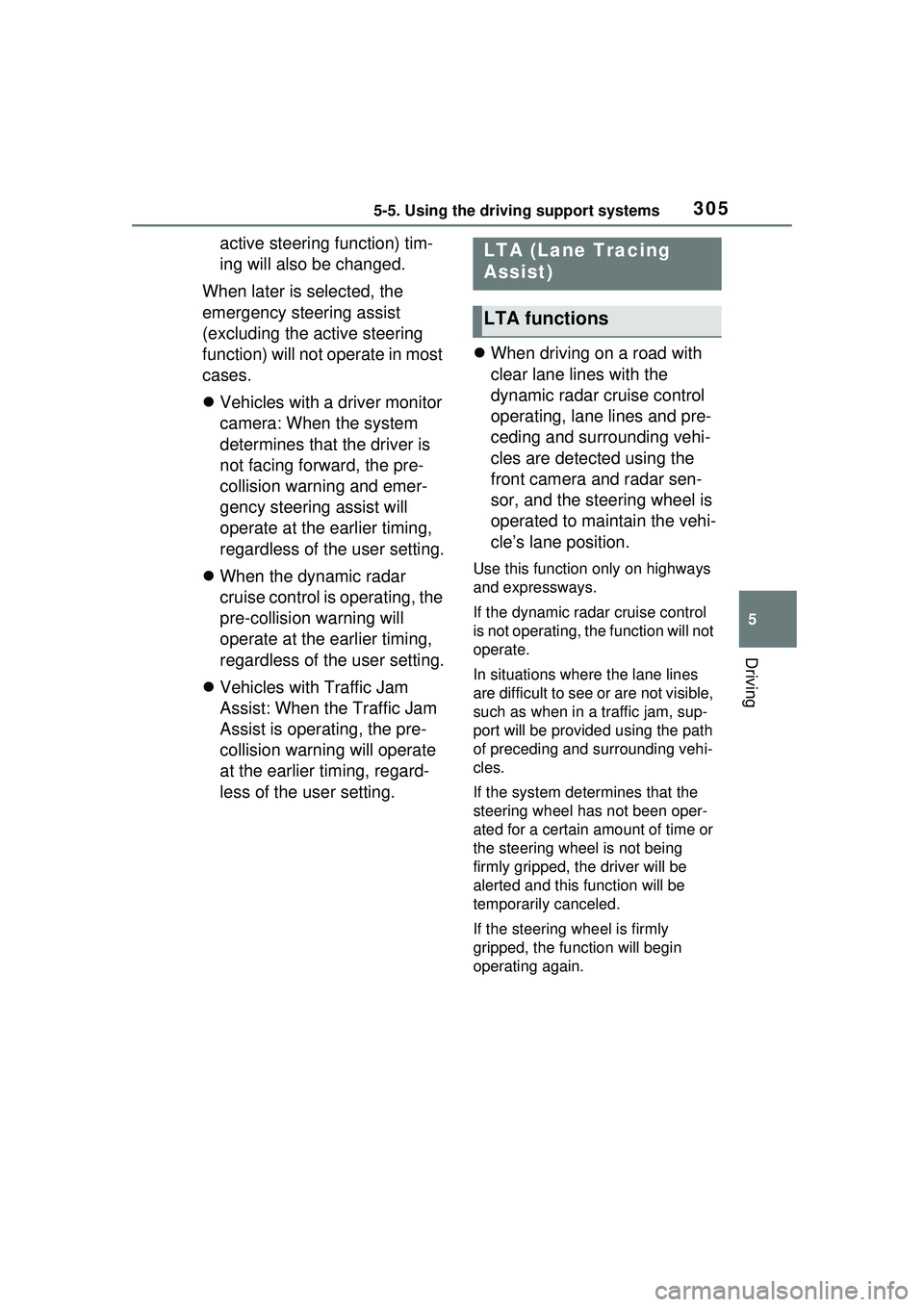
3055-5. Using the driving support systems
5
Driving
active steering function) tim-
ing will also be changed.
When later is selected, the
emergency steering assist
(excluding the active steering
function) will not operate in most
cases.
Vehicles with a driver monitor
camera: When the system
determines that the driver is
not facing forward, the pre-
collision warning and emer-
gency steering assist will
operate at the earlier timing,
regardless of the user setting.
When the dynamic radar
cruise control is operating, the
pre-collision warning will
operate at the earlier timing,
regardless of the user setting.
Vehicles with Traffic Jam
Assist: When the Traffic Jam
Assist is operating, the pre-
collision warning will operate
at the earlier timing, regard-
less of the user setting.
When driving on a road with
clear lane lines with the
dynamic radar cruise control
operating, lane lines and pre-
ceding and surrounding vehi-
cles are detected using the
front camera and radar sen-
sor, and the steering wheel is
operated to maintain the vehi-
cle’s lane position.
Use this function only on highways
and expressways.
If the dynamic radar cruise control
is not operating, the function will not
operate.
In situations where the lane lines
are difficult to see or are not visible,
such as when in a traffic jam, sup-
port will be provi ded using the path
of preceding and surrounding vehi-
cles.
If the system determines that the
steering wheel has not been oper-
ated for a certain amount of time or
the steering wheel is not being
firmly gripped, the driver will be
alerted and this function will be
temporarily canceled.
If the steering wheel is firmly
gripped, the f unction will begin
operating again.
LTA (Lane Tracing
Assist)
LTA functions
Page 306 of 680
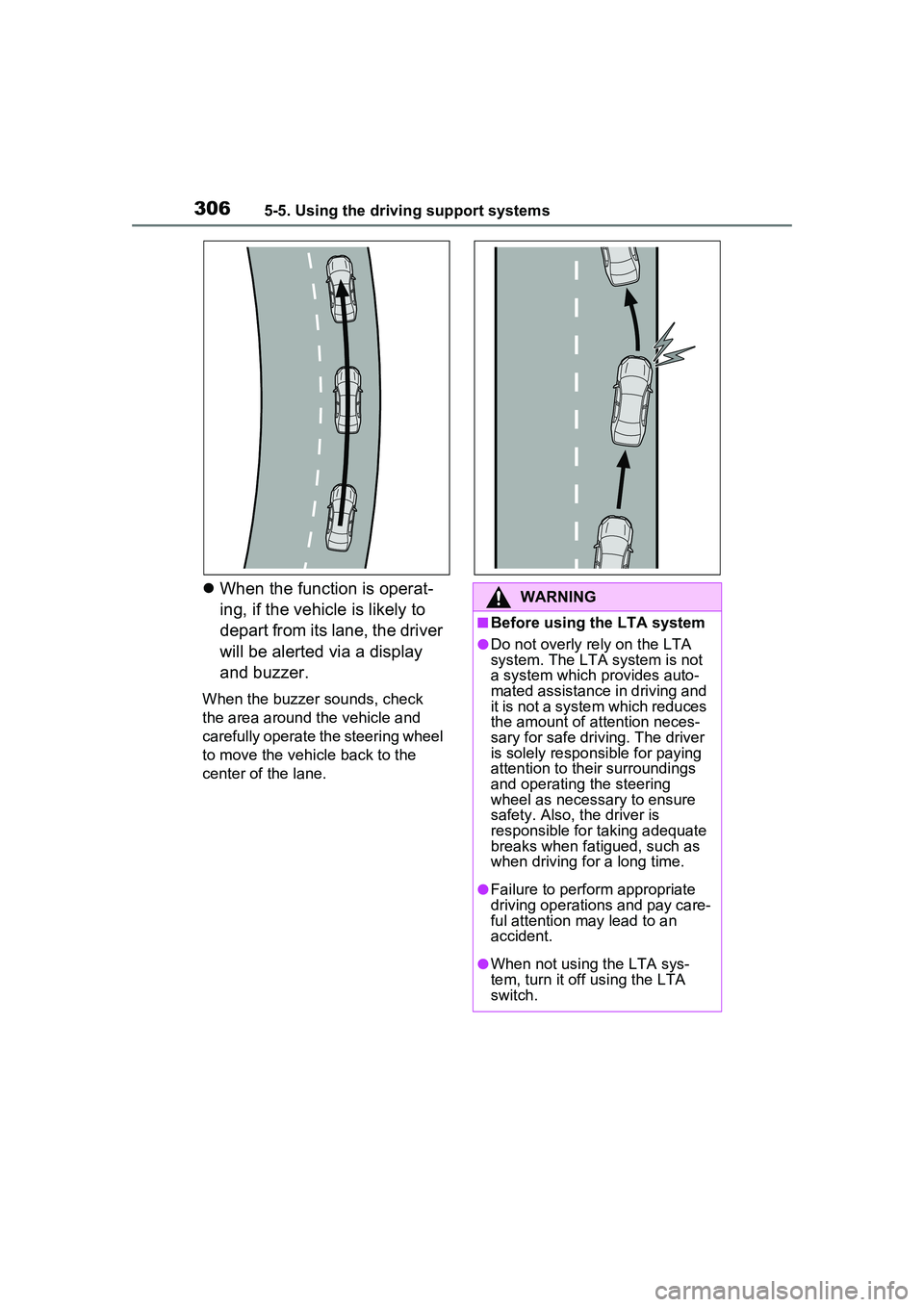
3065-5. Using the driving support systems
When the function is operat-
ing, if the vehicle is likely to
depart from its lane, the driver
will be alerted via a display
and buzzer.
When the buzzer sounds, check
the area around the vehicle and
carefully operate the steering wheel
to move the vehicle back to the
center of the lane.
WARNING
■Before using the LTA system
●Do not overly rely on the LTA
system. The LTA system is not
a system which provides auto-
mated assistance in driving and
it is not a system which reduces
the amount of attention neces-
sary for safe driv ing. The driver
is solely responsible for paying
attention to their surroundings
and operating the steering
wheel as necessary to ensure
safety. Also, the driver is
responsible for taking adequate
breaks when fatigued, such as
when driving for a long time.
●Failure to perform appropriate
driving operations and pay care-
ful attention may lead to an
accident.
●When not using the LTA sys-
tem, turn it off using the LTA
switch.
Page 307 of 680
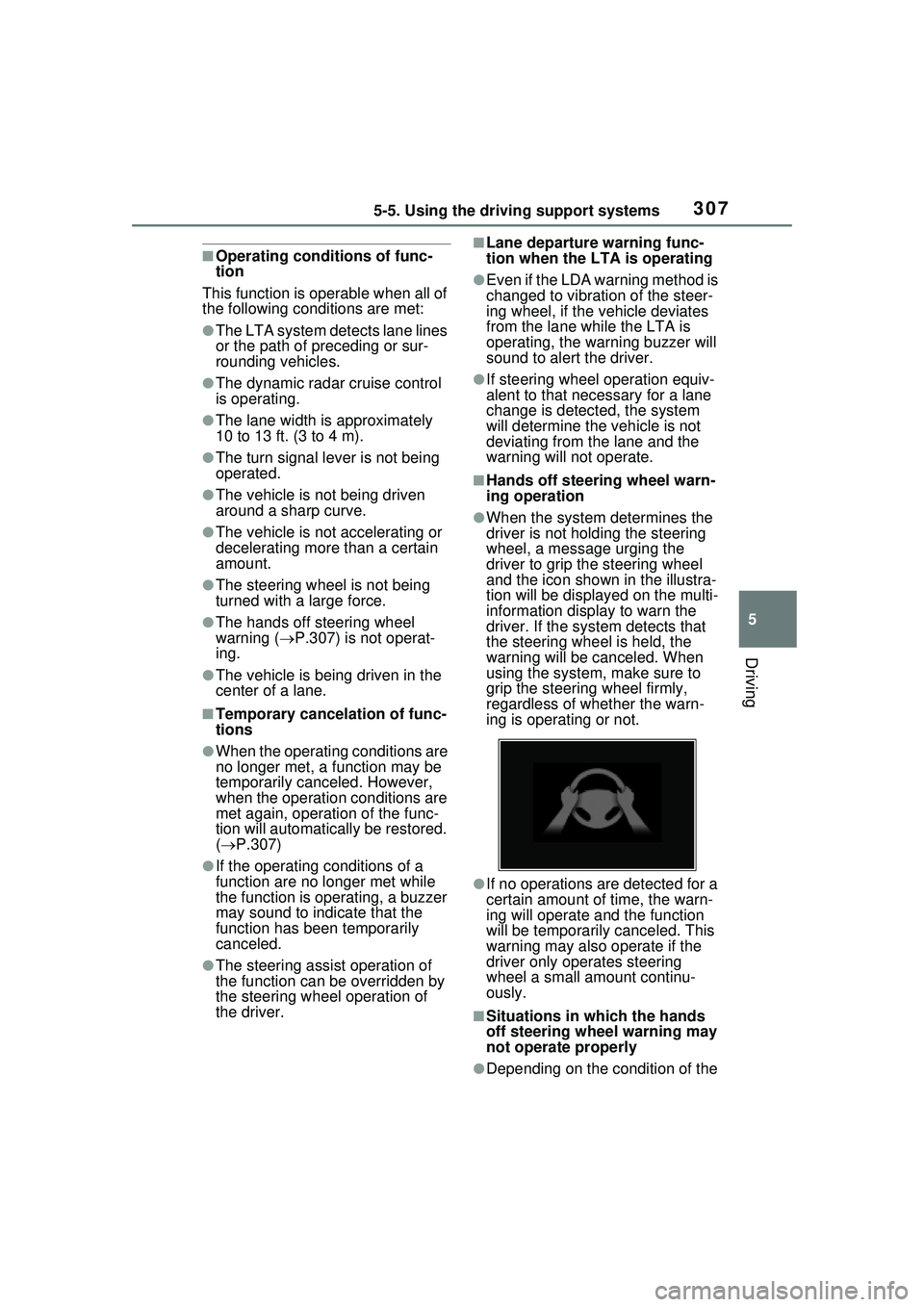
3075-5. Using the driving support systems
5
Driving
■Operating conditions of func-
tion
This function is operable when all of
the following conditions are met:
●The LTA system detects lane lines
or the path of preceding or sur-
rounding vehicles.
●The dynamic radar cruise control
is operating.
●The lane width is approximately
10 to 13 ft. (3 to 4 m).
●The turn signal lever is not being
operated.
●The vehicle is not being driven
around a sharp curve.
●The vehicle is not accelerating or
decelerating more than a certain
amount.
●The steering wheel is not being
turned with a large force.
●The hands off steering wheel
warning ( P.307) is not operat-
ing.
●The vehicle is being driven in the
center of a lane.
■Temporary cancelation of func-
tions
●When the operating conditions are
no longer met, a function may be
temporarily canceled. However,
when the operation conditions are
met again, operation of the func-
tion will automatically be restored.
( P.307)
●If the operating conditions of a
function are no longer met while
the function is operating, a buzzer
may sound to indicate that the
function has been temporarily
canceled.
●The steering assist operation of
the function can be overridden by
the steering wheel operation of
the driver.
■Lane departure warning func-
tion when the LTA is operating
●Even if the LDA warning method is
changed to vibration of the steer-
ing wheel, if the vehicle deviates
from the lane while the LTA is
operating, the warning buzzer will
sound to alert the driver.
●If steering wheel operation equiv-
alent to that necessary for a lane
change is detected, the system
will determine the vehicle is not
deviating from the lane and the
warning will not operate.
■Hands off steering wheel warn-
ing operation
●When the system determines the
driver is not holding the steering
wheel, a message urging the
driver to grip the steering wheel
and the icon show n in the illustra-
tion will be displayed on the multi-
information display to warn the
driver. If the system detects that
the steering wheel is held, the
warning will be canceled. When
using the system, make sure to
grip the steering wheel firmly,
regardless of whether the warn-
ing is operating or not.
●If no operations are detected for a
certain amount of time, the warn-
ing will operate an d the function
will be temporarily canceled. This
warning may also operate if the
driver only operates steering
wheel a small amount continu-
ously.
■Situations in which the hands
off steering wheel warning may
not operate properly
●Depending on the condition of the
Page 308 of 680
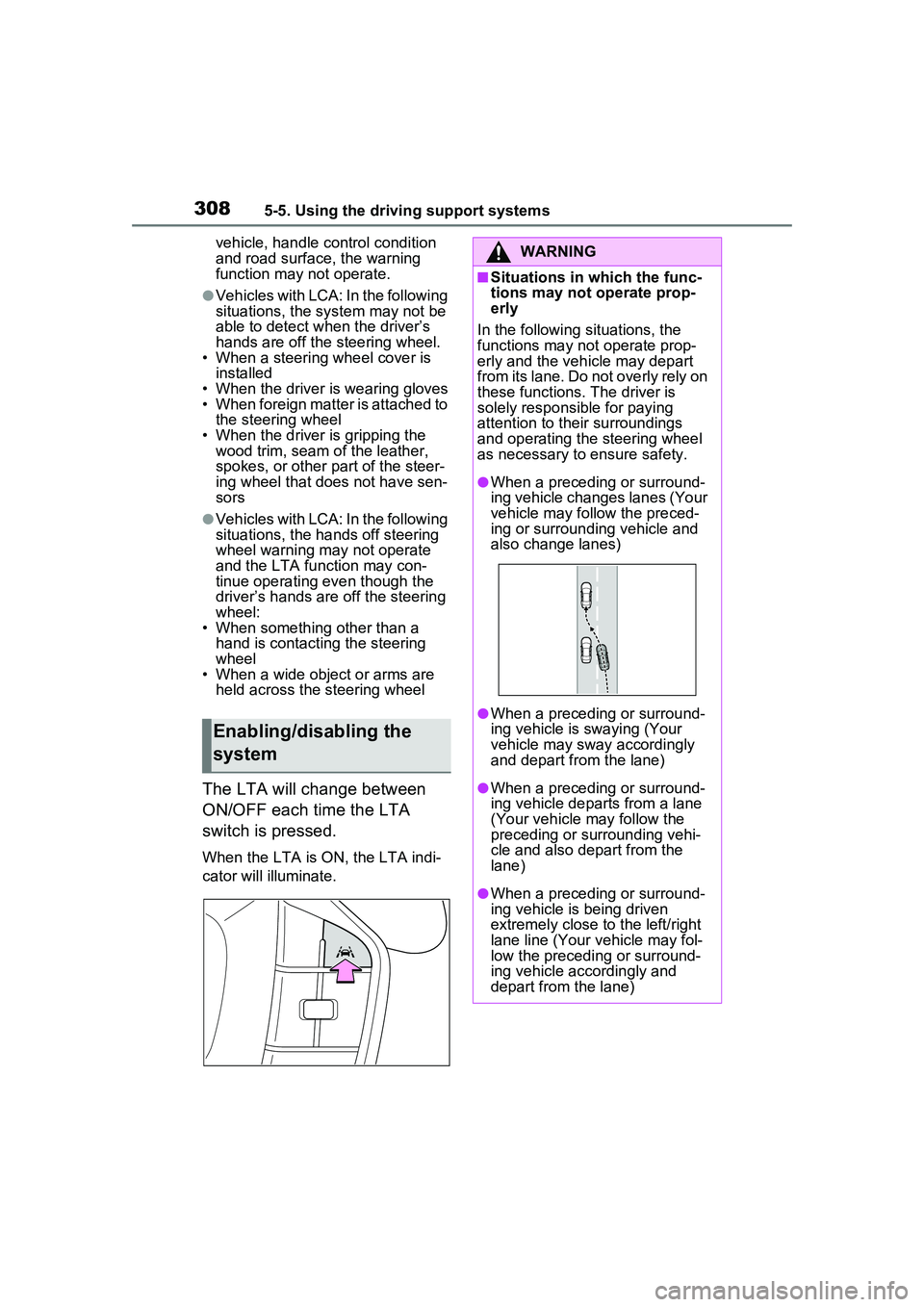
3085-5. Using the driving support systems
vehicle, handle control condition
and road surface, the warning
function may not operate.
●Vehicles with LCA: In the following
situations, the system may not be
able to detect when the driver’s
hands are off the steering wheel.
• When a steering wheel cover is
installed
• When the driver is wearing gloves
• When foreign matter is attached to
the steering wheel
• When the driver is gripping the wood trim, seam of the leather,
spokes, or other pa rt of the steer-
ing wheel that does not have sen-
sors
●Vehicles with LCA: In the following
situations, the hands off steering
wheel warning may not operate
and the LTA function may con-
tinue operating even though the
driver’s hands are off the steering
wheel:
• When something other than a
hand is contacting the steering
wheel
• When a wide object or arms are
held across the steering wheel
The LTA will change between
ON/OFF each time the LTA
switch is pressed.
When the LTA is ON, the LTA indi-
cator will illuminate.
Enabling/disabling the
system
WARNING
■Situations in which the func-
tions may not operate prop-
erly
In the following situations, the
functions may not operate prop-
erly and the vehicle may depart
from its lane. Do not overly rely on
these functions. The driver is
solely responsible for paying
attention to their surroundings
and operating the steering wheel
as necessary to ensure safety.
●When a preceding or surround-
ing vehicle changes lanes (Your
vehicle may follow the preced-
ing or surrounding vehicle and
also change lanes)
●When a preceding or surround-
ing vehicle is swaying (Your
vehicle may sway accordingly
and depart from the lane)
●When a preceding or surround-
ing vehicle departs from a lane
(Your vehicle may follow the
preceding or surrounding vehi-
cle and also depart from the
lane)
●When a preceding or surround-
ing vehicle is being driven
extremely close to the left/right
lane line (Your vehicle may fol-
low the preceding or surround-
ing vehicle accordingly and
depart from the lane)
Page 309 of 680
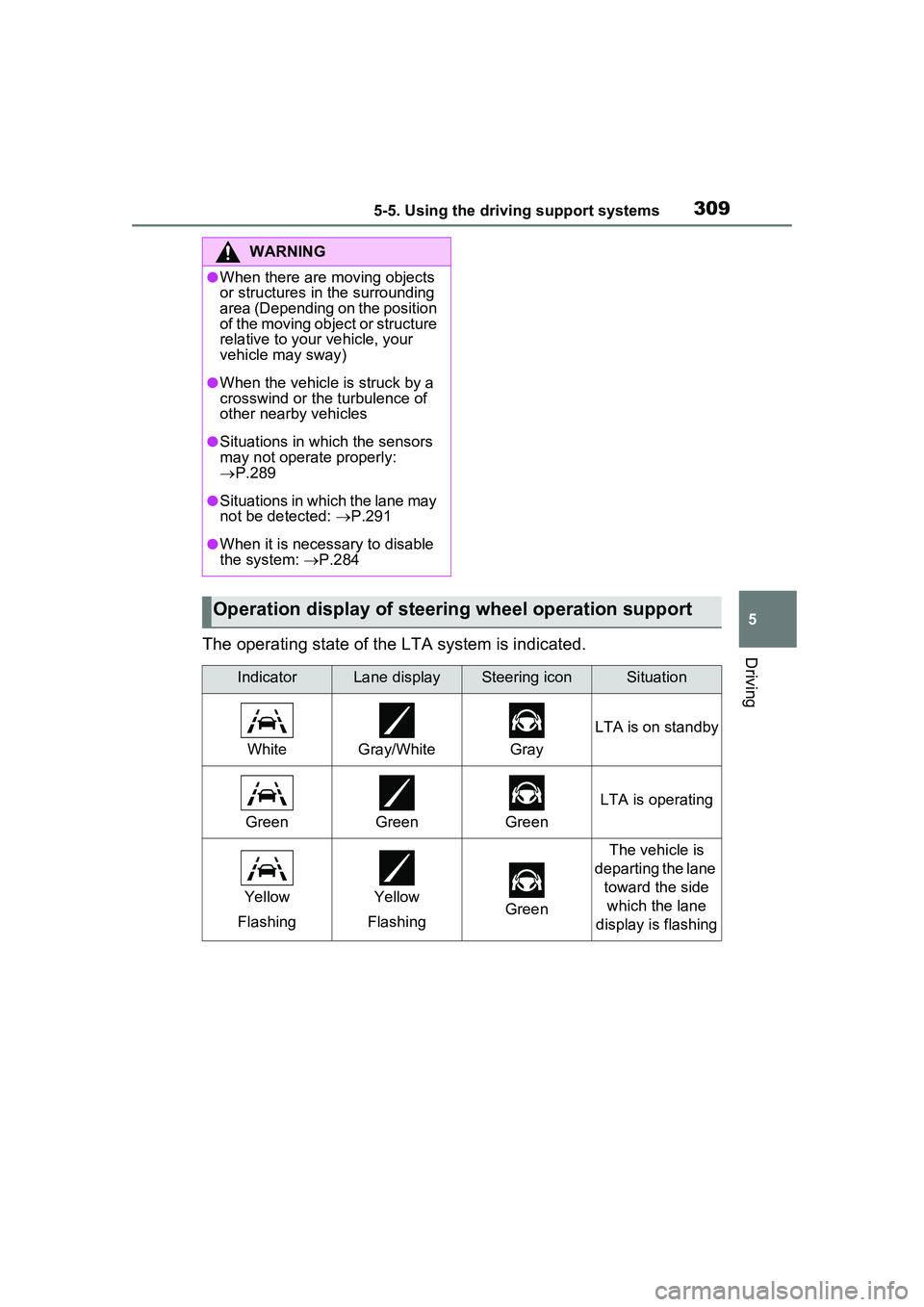
3095-5. Using the driving support systems
5
DrivingThe operating state of the LTA system is indicated.
WARNING
●When there are moving objects
or structures in the surrounding
area (Depending on the position
of the moving object or structure
relative to your vehicle, your
vehicle may sway)
●When the vehicle is struck by a
crosswind or the turbulence of
other nearby vehicles
●Situations in which the sensors
may not operate properly:
P.289
●Situations in which the lane may
not be detected: P.291
●When it is necessary to disable
the system: P.284
Operation display of steering wheel operation support
IndicatorLane displaySteering iconSituation
WhiteGray/WhiteGray
LTA is on standby
GreenGreenGreen
LTA is operating
Yellow
FlashingYellow
FlashingGreen
The vehicle is
departing the lane toward the side which the lane
display is flashing
Page 310 of 680
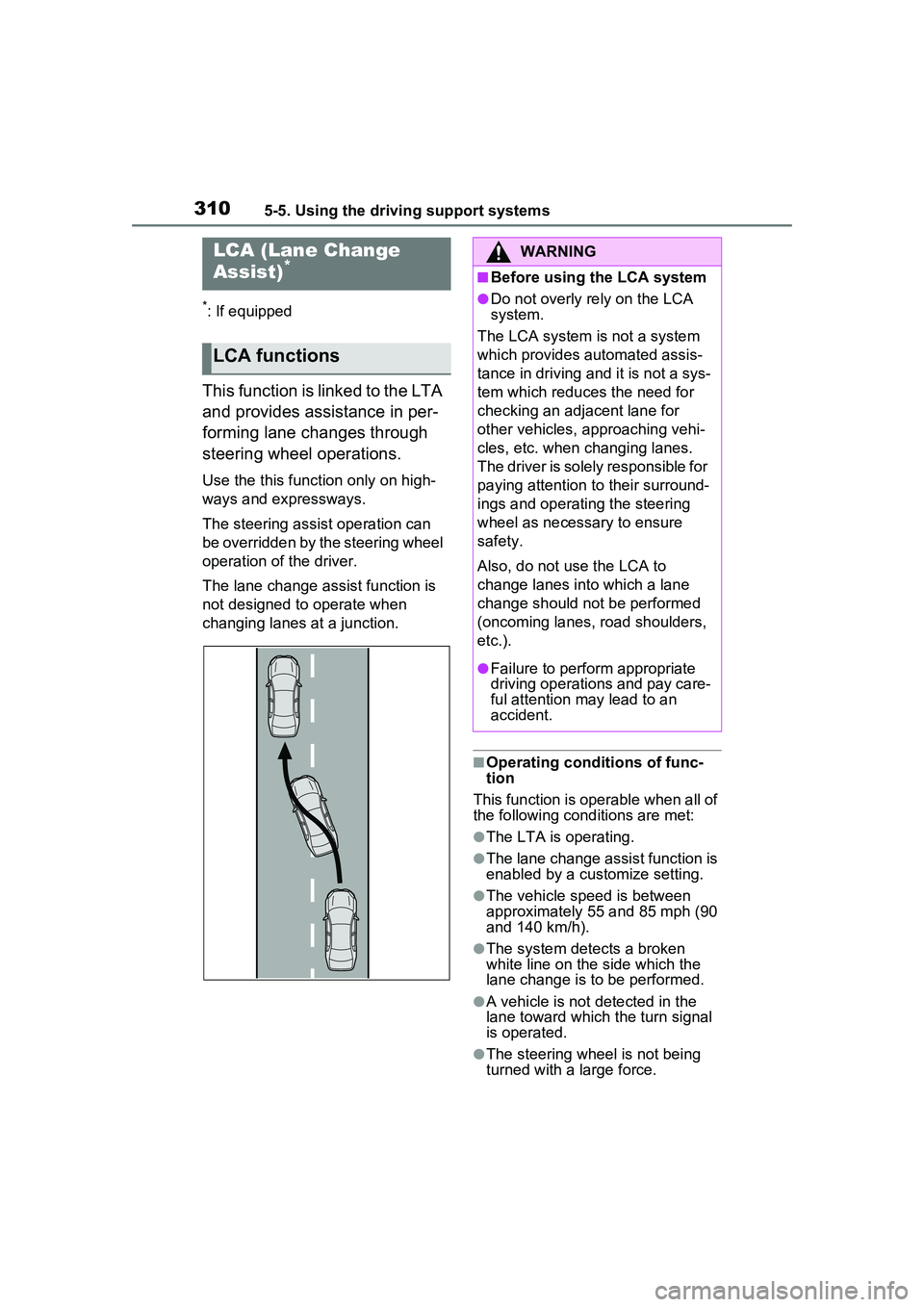
3105-5. Using the driving support systems
*: If equipped
This function is linked to the LTA
and provides assistance in per-
forming lane changes through
steering wheel operations.
Use the this function only on high-
ways and expressways.
The steering assist operation can
be overridden by the steering wheel
operation of the driver.
The lane change assist function is
not designed to operate when
changing lanes at a junction.
■Operating conditions of func-
tion
This function is operable when all of
the following conditions are met:
●The LTA is operating.
●The lane change assist function is
enabled by a customize setting.
●The vehicle speed is between
approximately 55 and 85 mph (90
and 140 km/h).
●The system detects a broken
white line on the side which the
lane change is to be performed.
●A vehicle is not detected in the
lane toward which the turn signal
is operated.
●The steering wheel is not being
turned with a large force.
LCA (Lane Change
Assist)*
LCA functions
WARNING
■Before using the LCA system
●Do not overly rely on the LCA
system.
The LCA system is not a system
which provides automated assis-
tance in driving and it is not a sys-
tem which reduces the need for
checking an adjacent lane for
other vehicles, approaching vehi-
cles, etc. when changing lanes.
The driver is solely responsible for
paying attention to their surround-
ings and operating the steering
wheel as necessary to ensure
safety.
Also, do not use the LCA to
change lanes into which a lane
change should not be performed
(oncoming lanes, road shoulders,
etc.).
●Failure to perform appropriate
driving operations and pay care-
ful attention may lead to an
accident.